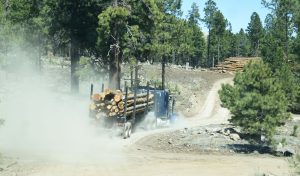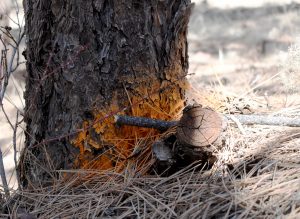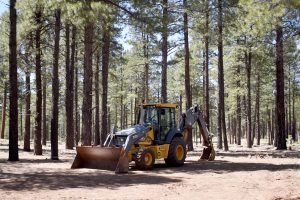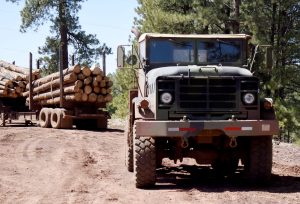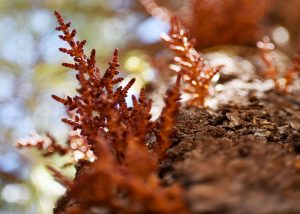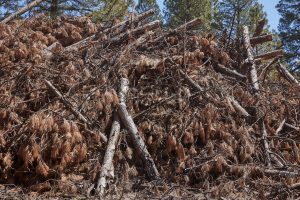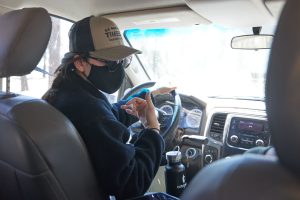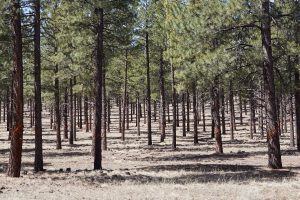EDS: An earlier version of this story had incorrect information in two captions about how trees on A-1 Mountain in the Coconino Forest in Flagstaff are marked for removal during the thinning process. Trees marked with blue or no color are designated for removal while orange markings indicate the tree should be left alone. The captions below have been corrected, but clients who used earlier versions are asked to run the correction found here.
- Slug: BC-CNS Forest Health, 2,425 words.
- 1 video here, credit Fiona L.Q. Flaherty
- 1 interactive here, credit Anna Campbell/Cronkite News
- 10 photos and captions below.
By Fiona L.Q. Flaherty
Cronkite News
FLAGSTAFF – The electric blue sky frames a stand of ponderosa pines – their ramrod trunks picket the forest floor as sunlight floods the ground. A breeze tickles the green needles, mingling dust with the heady scent of pine. At first, it’s easy to mistake the sound of branches in the wind for a rushing stream.
But this open stand of trees, in the Coconino National Forest off Interstate 40 west of Flagstaff, is dry and tough. Several decades ago, this area was “thinned” — trees that were too close together, poorly formed or diseased — were removed as part of a project called the A-1 Timber Sale.
Now, although drought-stressed, this stand, with lots of space between trees, is healthy, said Elise Sawa, a forester with the Coconino National Forest.
A healthy forest, she noted, might not look like you’d expect.
“People like thick forests. That’s what they want to see, especially for people who live in urban environments like Phoenix,” Sawa said. “It’s hard to try and change people’s perceptions of what healthy actually is, and many people don’t have the resources to come and see it.
“And it’s not like they are teaching this in schools, either. This is the perfect storm.”
This perfect storm is the confluence of drought, increased risk of wildfire and the vulnerability of trees to insects, disease and people. But this stand in the Coconino is a good example of what “healthy” means for a forest.
The trees now have space to get enough light and water to grow, Sawa said, and to resist drought, bark beetles and wildfires.
Just across the red dirt road that twists along the southeastern edge of this healthy stand is a tangled mat of unhealthy trees. The ponderosas there are thin, their trunks curved from struggling to find light.
Sawa said most of the trees in this stand are too small in diameter to be removed under U.S. Forest Service guidelines. Trees need time to grow so foresters can see how they mature, and if you cut too many small trees, you risk limiting the genetic pool and regenerative capacity of the forest, she said.
In addition to being small, Sawa said, these trees also are drought-stressed.
“You can also see some have red needles on them. That means that they’re not getting as much water as they would like,” she said. “I’m also seeing a lot less light on the ground for new regeneration. These trees are just trying to survive.”
Forests across Arizona
Many of Arizona’s forests look like this tangled stand, experts say, and from the ponderosa and hardwoods in the north to the mixed conifers in the south, they’re in bad shape.
Unusual die-offs of junipers and other trees due to drought stress are occurring in the state, the Arizona Department of Forestry and Fire Management reported last year.
A 20-plus year drought – coupled with decades of fire-suppression policies and relentlessly rising temperatures driven by climate change – are behind much of this unhealthy transformation, calling into question how forest health can be restored during a time of catastrophic wildfires and an increasing number of people moving to densely wooded areas.
According to the National Oceanic and Atmospheric Administration’s National Centers for Environmental Information, “temperatures in Arizona have risen 2.5 degrees Fahrenheit since the beginning of the 20th century,” and precipitation remains highly variable, making for tinder dry trees that can fuel wildfires, which come earlier every year.
Take the Tunnel fire, which broke out northeast of Flagstaff on April 17 and forced hundreds of households to evacuate, prompting Gov. Doug Ducey to declare a state of emergency for Coconino County.
This is an example of how fire seasons across the West are rapidly becoming year-long, straining not only ecosystems’ ability to recover, but also the people who manage, live in and enjoy the forests.
But in Arizona, there are some advantages, said Andrew Sánchez Meador, the executive director of the Ecological Restoration Institute at Northern Arizona University. The Coconino National Forest, for example, has one of the largest continuous stands of ponderosa pine forests in the world.
“If you were to design a species that could handle drought, fire and warmer temperatures, ponderosa pine is great. It evolved over time with those attributes,” Sánchez Meador said. “Those are the conditions for which it functions best. But unfortunately, we’ve increased density, removed and suppressed fire and changed the species composition.”
Not all forests in Arizona are like the Coconino. Arizona’s diverse geography coupled with enormous elevation changes means the forests are incredibly diverse, Sánchez Meador said.
“Arizona’s forests are arid, high elevation forests which are super dry. They have evolved to be drought tolerant,” he said. “Historically, there was a lot of fire, and so most of our forests, to some degree or another, have some kind of fire adaptation to them, too.”
Arizona goes from high desert – home to saguaros, creosote, mesquite and palo verdes – to woodlands and grasslands in the eastern and western part of the state. Farther north is where the ponderosa pine and mixed conifer forests are, and in some cases, spruce and fir, Sánchez Meador said.
Southern Arizona also has a unique type of forest found on the sky islands near the U.S.-Mexico border.
“We have all these little cinder cones and uplifted small mountains,” Sánchez Meador said. “As you go up, temperatures get cooler and precipitation falls, and so you get increases in moisture.”
With all this diversity, it can be difficult to define a healthy forest. Sánchez Meador said it comes down to the symptoms a forest shows.
“Our symptoms in Arizona are uncharacteristic fires, which are fires that are burning at high severity,” he said. “When they burn, they destroy forested landscape.”
Other symptoms include tree die-off from drought, fire, insects and disease, which are occurring more often than in the past, Sánchez Meador said.
“I would say those are all symptoms of a chronic problem, which is that our forests in Arizona are largely unhealthy,” he said. “A healthy forest should be able to recover. But our systems are degraded, and they are not recovering. We just aren’t seeing the recovery we would expect to see in a healthy system.”
Why forest health matters: water, wildfire and climate change
The importance of forest health goes far beyond aesthetics and recreation. Forests protect watersheds, which ultimately mean clean drinking water for Arizonans, Sánchez Meador said.
Phoenix, one of the fastest growing cities in the U.S., gets most of its water from the Salt and Verde rivers, as well as from the Colorado River. The headwaters of the Verde are in Yavapai County; the Salt begins in Cochise County.
“Historically, these forests would have been really open,” Sánchez Meador said. “Snow would have melted and gone into the groundwater. But because our forests are so thick today, snow evaporates back into the atmosphere, or runs off. And it never actually makes it back into our groundwater because our forests are degraded and they are not functioning the way we would want them to.”
Aly McAlexander, a forest health specialist with the Arizona Department of Forestry and Fire Management, sees this degradation first hand.
McAlexander is out in the woods two to three times a week, looking for the impacts of disease and drought, speaking with homeowners about trees on their properties or helping the department survey the forests from a small plane.
The department surveys the national forests, state lands and tribal lands around Arizona – over 17 million acres in total – during a six to eight week period during the summer, McAlexander said.
“We are looking for insect and disease outbreaks that are occurring that year so we can give a better overall view of what is really happening in all of Arizona,” she said. They go back and ground check some spots if they can’t identify them from the air.
The findings from the 2021 aerial survey indicated that more than 400,000 acres of state land had observable drought damage and 500,000 acres were damaged by bark beetle infestations.
This aerial survey usually is taken once a year, said McAlexander, who has been keeping an eye on Arizona’s forests for two years. But last year, the department conducted a rare supplemental survey to gauge how drought has affected juniper trees.
“We were seeing a large acreage of juniper tree die-off in northern Arizona and a little west of Sedona. We are talking about thousands of acres,” she said.
The impact of drought is obvious, she said.
“We’ve seen the trees begin to have this dingy kind of graying or browning color, depending on the species. There’s an overall stress,” McAlexander said.
Wildfire likes dry, densely packed stands, she said, and Arizona has a lot of those right now.
“With the drought stress going on, trees’ needles are drier because of that lack of moisture, and they’re also fairly densely packed, and this can make them easier to ignite,” she said. “Those things can lead to high intensity fires.”
On top of that, unhealthy trees aren’t as productive, McAlexander said.
“When we have these stressed trees, they’re more focused on trying to maintain their own health, so they’re not able to produce as much oxygen or take in as much carbon dioxide,” she said. “The healthier the stand, the more benefits it provides.”
Carbon dioxide is a major contributor to climate change, which is deepening drought and raising temperatures across the Southwest.
Creating resilient forests
When it comes to climate change, McAlexander said, restoring forest health is a race against time. But making a forest resilient takes decades.
“Trees need time to grow,” she said. “Any changes that we’re expecting to see, whether that’s tree planting or restoration projects, are going to take time for the forests to be able to reach a more mature state.”
In Arizona, much is being done to restore forests to health. Thinning and prescribed burning are the most effective prescriptions for a sick forest, experts say.
Thinning, or the cutting of specific trees, reduces tree stand density, which allows other trees to get water and sunshine to grow. This strategy, McAlexander said, is critical to fire prevention.
According to the Forest Service, “overgrown forests are one of the key contributing factors to the current wildfire crisis in the West,” and “science shows that thinning and fuels treatments work.”
Thinning also robs fire of fuel. Sánchez Meador said thinning opens the door for prescribed burns, which reintroduces “healthy” fire to the landscape by reducing fuel loads and helping fire-dependent species spread their seeds. Prescribed burns only take place with meticulous planning under tightly controlled conditions, according to the National Park Service.
“Thinning and burning together is a sustainable approach, when combined with where we live and the way we live as humans, that we really have to think about going forward,” Sánchez Meador said.
Repeating prescribed burns every few years helps to repair the damage from years of fire-suppression, which is why forests have become so thick and there’s so much fuel load for fire, Sánchez Meador said.
“Fire can be managed for some kind of positive benefit, like back burning, which would rob wildfires of their fuel. But unfortunately, our forests are so dense that we can’t come right in with fire,” he said.
Can Arizona build healthy, resilient forests?
Forestry comes down to human behavior, McAlexander said. People can promote forest health by maintaining their properties and learning how to be safe in dry months.
But maintaining the health and safety of forests is also a huge collaborative effort between state, and federal agencies, as well as city governments and private companies.
“I have so many great co-workers that really helped me be able to answer the questions about things I can’t get out and see on the ground,” McAlexander said. “It’s great that we have such a great relationship between our organizations. Otherwise, this probably would be way more difficult.”
Funding is another factor in forestry, especially as fire seasons lengthen.
According to the research and analysis company ValuePenguin, “from 2011 to 2020, authorities spent at least $1.3 billion on fighting wildfires per year,” and these costs are expected to increase.
Additionally, the federal wildfire appropriation for fiscal year 2020 “was $6.11 billion, the highest appropriation to date,” the Congressional Research Service reported.
Earlier this year, the U.S. Forest Service and its parent agency, the Department of Agriculture, launched a 10-year plan to confront the wildfire crisis by investing $131 million in fiscal year 2022 alone to thin and treat forests in eight states including Arizona.
Thinning unhealthy areas reduces wildfire risk, McAlexander said.
“It allows us to meet that goal of being able to treat more acres, with areas in wildland urban interfaces being an initial priority,” she said. “The more we can treat, then the less communities will be at risk. Again, it really comes down to the number of acres that we can get treated as quickly as possible so that we can reduce that risk as quickly as possible.”
Thinning in Arizona also involves finding businesses to do the work, McAlexander said.
“It’s a lot of acres that need to be treated and a lot of trees that need to be removed,” she said. “Having more companies or loggers could also increase the capacity [and] we would be treating more acres per year, but Arizona just doesn’t also have a huge logging industry in comparison to other states.”
Last year Ducey signed the Arizona Healthy Forest Initiative which allocates $24.5 million for reducing fuels in the forest and to hire more people to help do the work.
“We are seeing exceptional growth in our program right now with the governor’s funding,” McAlexander said. “I was only able to have one to two foresters help me maybe once or twice a month because they had their own projects. But now those foresters have hired two technicians. So we’ve essentially increased by three times the number of foresters before.”
Restoring Arizona’s forests to health is feasible, McAlexander said, but it’s going to take decades of work, especially if we want to get the forests to a place where they can withstand a changing climate.
“The sooner we can get to our goal and reach the target densities that we’re looking for, the sooner we can do better,” McAlexander said. “But the longer we take, the more issues we could be dealing with. By the time you know, we’re 30, 40 years down the road, there could be other things that we are not prepared for.”
For more stories from Cronkite News, visit cronkitenews.azpbs.org.
^__=
